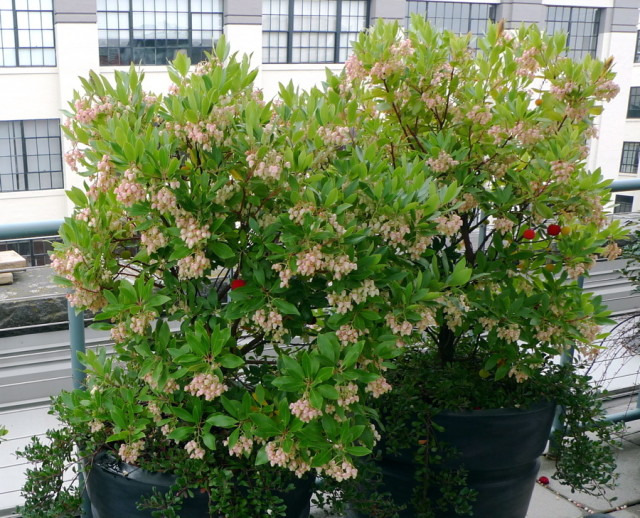Strawberry Tree

Arbutus unedo ‘Oktoberfest’, a compact variety growing about 6-8’ tall and wide, with abundant shell-pink flowers and copious fruit production.
The strawberry tree (Arbutus unedo ) – closely related to our native madrone (Arbutus menziesii) – is a tough, reliable shrubby tree for difficult spots. Hailing from Southern Europe and Ireland, the strawberry tree is accustomed to seasonal (winter) rainfall and has proven itself highly drought tolerant and adaptable in our climate.
In our region, strawberry tree is perfect for a hot, dry sunny spot with lean soil- but it can also accept partial shade and woodland margin conditions, although the habit will be more open and sparsely leafed. Strawberry tree is one of the most moisture-tolerant of all Arbutus, accepting garden conditions with summer watering, although it won’t tolerate poor drainage. It also does well in containers, which isn’t true for many drought-tolerant, Mediterranean shrubs or trees.
For some years, this plant seemed all too common in the landscape (it’s easy and cheap to propagate), and the way it was often sheared into a meatball shape did little to enhance its image. But with the appearance of some more compact, desirable cultivars with larger fruit and pinkish flowers, there are myriad good reasons to take a fresh look at the plant.
For one, strawberry tree has fantastic winter interest.
Let’s start with the foliage. It’s a rich dark green that looks intensely vibrant in our gray, overcast winters. The surfaces of the leaves have an ever-so-slight sheen and the leaf margins are lightly serrated. The handsome reddish twigs and leaf petioles really pop, as does the warm brown, slightly shaggy bark. And then there are the fruit and flowers, which usually appear simultaneously starting in October.
Strawberry tree has white or pink, waxy, urn-shaped flowers produced in abundance at the tips of the branches. The spherical, one-half to one-inch diameter fruit starts out green, turning pale buttercup yellow and finally ripening a rich reddish orange.
While most strawberry trees are at their peak of flowering and fruiting in October and early November, they continue to look wonderful even as the flowers shed and the fruit are consumed by birds during December and January. The cold weather brings out burgundy and reddish tints in the foliage, which only enhances the tree’s charm.
Arbutus unedo – the straight species – is a small tree with typically white, urn-shaped flowers, reaching about 15-30’ tall over time in the wild. Fruit is reputedly smaller (approx. half an inch diameter) in the species. Most cultivars (several are listed below) are more compact in habit and have larger fruit. Strawberry tree tolerates temperatures down to about 0-10F, although the foliage and even bark can suffer at the lower end of its hardiness.
Arbutus unedo f. rubra – about same size as the species but with pink-tinged flowers
There is some conflicting information about the differences between the compact forms of strawberry tree. I offer my own observations on the differences. Please note: the heights listed suggest the height after approximately 10-15 years in the ground.
Arbutus unedo ‘Compacta’ – about 8-12’ tall (narrower than wide).
Arbutus unedo ‘Elfin King’ – 6-8’ tall (narrower than wide) slowly. Pinkish-white flowers.
Arbutus unedo ‘Oktoberfest’ – 6-8’ tall and wide (narrower than wide), slowly. Pink flowers, abundant fruit. Apparently a seedling of Compacta with darker pink flowers and a more compact habit.
There are some other specialty cultivars such as the oak-leafed Arbutus unedo ‘Quercifolia’ but I haven’t found any local sources for them.
Sources:
Cistus Design Nursery
Cornell Farms Nursery
Gossler Farms Nursery
Portland Nursery
